Band Structures Analysis of Elastic Waves Propagating along Thickness Direction in Periodically Laminated Piezoelectric Composites
Abstract
:1. Introduction
2. Basic Model
3. State Space Formalism
3.1. Equations Governing the Elastodynamics of a Layer
3.2. Derivation of the State Equation of a Layer
3.3. Traveling Wave Solution of the State Equation for a Layer
4. Transfer Matrix Method
5. Numerical Examples
5.1. Tuning the Dispersion Characteristics of P-Wave Depend on the Electrical Boundary
5.1.1. Validation of the Proposed Formulation for P-Wave Dependent on the Electric Field
5.1.2. Influence of the Electrode Thickness on Dispersion of P-Wave Dependent on the Electric Field
- The higher mode spectra are more sensitive to the electrode thickness. As the electrode thickness is less than certain ratio to the thickness of associated piezoelectric layer, say , the first two wavenumber spectra of all waves are nearly unaffected by the electrode thickness. As the electrode thickness reaches to of the thickness of piezoelectric layer, the 3rd and higher order spectra begin to be influenced by the electrode thickness. As the thickness ratio between electrode and host piezoelectric layer reaches to , all modes of spectra are obviously influenced.
- When the electrode thickness shows effect on the wavenumber spectra, it has the same effect on all waves in that frequency range, since the alteration of the electrode thickness essentially equals to changing the unit-cell configuration. With the increasing of the electrode thickness, the wavenumber spectra deform to lower frequency side, so that the central frequencies of bandgaps are lowered. However, the widths of bandgaps are not consistently changed with the electrode thickness.
- As the electrode thickness is less than , the electrode thickness does not affect the dispersion characteristics of all waves.
5.1.3. Influence of Electrical Boundaries on P-Waves Dependent on the Electric Field
- Some orders of phase constant spectra are sensitive to the applied capacitance, like the second spectra, but others are not, like the first and the third spectra.
- As the applied capacitance increases from to positive values, the wavenumber spectra change gradually from those of the electric-open condition to those of the electric-short condition as expected, i.e., these phase constant spectra deform to the lower frequency side. Thus, the central frequencies of most bandgaps and passbands decrease with the enlarging of the capacitance. However, the bandgap widths may be either narrower like the first stopband in Figure 5a or wider like the second stopband there.
- As the applied capacitance decreases from to negative values, the wavenumber spectra of the P-wave do not follow the opposite rule of positive capacitance and do show very complex alterations that seems can not be described by a uniform rule. Nevertheless, the phenomena that some attenuation constant spectra have pole at certain frequency in bandgap and the corresponding phase constant jumps from to , found by Kutsenko et al. [44] in studying the piezoelectric medium with periodically applied negative capacitance, are also discerned here as the capacitance is taken as and . Note that Kutsenko et al. [44] did provide the formula to determine the negative capacitance that leads to this unusual feature in wavenumber spectra for piezoelectric medium with periodically applied capacitance. But here we can not provide a similar formula for this purpose because of the complexity of our model, in which the inserted elastic layers and the mechanical effect of the electrodes have been further considered on the basis of the model in Kutsenko et al. [44].
- Some orders of the phase constant spectra are sensitive to the applied feedback control, like the first and second spectra in Figure 5c, but others are not, like the third spectrum there. Nevertheless, Figure 5d shows that as long as the gain coefficient is big enough, even the third spectrum alters. The phase constant spectra that are insensitive to the applied feedback control may not be definitely coincident with the spectra insensitive to the applied capacitance, like the first spectrum. The spectra that are insensitive to both conditions may correspond to wave modes mainly dominated by the mechanical effect.
- As the gain coefficient increases from , the wavenumber spectra change from those of the electric-short condition, which can be expected since corresponds to the electric-short condition, to the lower frequency side. Thus, the central frequencies of most bandgaps and passbands decrease with the enlarging of . However, the bandgap widths may be either wider like the second stopband in Figure 5c or change without coherence like the first stopband there.
- As the gain coefficient reaches or bigger, the phenomena that some attenuation constant spectra have pole at certain frequency in bandgap and the corresponding phase constant jumps from to , can also be discerned. This means that we can use the applied feedback control boundary to realize the same effect resulting from the negative capacitance, like the unusual dispersion feature emphasized here. But neither can we provide a formula to determine for achieving this unusual dispersion phenomenon because of the complexity of our model.
5.1.4. Properties of Frequency-Related Dispersion Curves of P-Wave Dependent on the Electric Field
5.2. Tuning the Dispersion Characteristics of S-Wave Depend on the Electrical Boundary
5.2.1. Validation of the Proposed Method for S-wave Dependent on the Electric Field
5.2.2. Influence of the Electrode Thickness on Dispersion of S-Wave Dependent on the Electric Field
5.2.3. Influence of Electrical Boundaries on S-Wave Dependent on the Electric Field
5.2.4. Properties of Frequency-Related Dispersion Curves of S-Waves Dependent on the Electric Field
6. Conclusions
- (1)
- In the theoretical derivation of the analysis method, this paper is limited to elastic waves along the thickness direction and to general periodic piezoelectric composites of orthotropic materials. It is found that in this case, the three elastic waves are all decoupled into one primary (P-) wave and two shear (S-) waves with perpendicular polarizations, and only one wave among them is influenced by the electric field. The situation with elastic waves propagating obliquely to the thickness direction or of general, periodically laminated piezoelectric composites with unit cells consisting of arbitrarily anisotropic constituent layers is under investigation.
- (2)
- The mechanical effect of electrodes must be considered in the modeling, as the electrode thickness surpasses of the thickness of host piezoelectric layer. In this case, the electrode thickness can also be used to adjust passively the band structures of the periodic piezoelectric composites.
- (3)
- The applying and switching electrical boundaries among the electric-open, applied electric capacitance, electric-short, and applied feedback control conditions are very effective for actively modulating the dispersion of the P-wave that is dependent on the electric field. In particular, the unusual dispersion feature, which means that at some frequencies in the bandgaps, the attenuation constant spectrum has a pole and the corresponding phase constant jumps from to , which results from the applied negative capacitance condition in other literature, can also be realized by the applied feedback control boundary. However, the applying and switching of the four electrical boundaries may be inefficient or even invalid for modulating the dispersion of the S-wave that is dependent on the electric field if the electromechanical coupling effect of the piezoelectric materials is not utilized properly. The dispersion curves associated with the electric-short condition play a benchmark role for designing the active control scheme.
Author Contributions
Acknowledgments
Conflicts of Interest
Appendix A. The Matrices Composed of Stiffness and Dielectric Constants
Appendix B. The Matrices Composed of Piezoelectric Constants
Appendix C. The Components of Matrices and
| Electrical boundaries | ||||
|---|---|---|---|---|
| Electric-open | ||||
| Applied capacitance | ||||
| Electric-short | ||||
| Applied feedback control | ||||
References
- Rytov, S.M. Acoustical properties of a thinly laminated medium. Sov. Phys. Acoust. 1956, 2, 68–80. [Google Scholar]
- Shah, A.H.; Datta, S.K. Harmonic waves in a periodically laminated medium. Int. J. Solids Struct. 1982, 18, 397–410. [Google Scholar] [CrossRef]
- Nayfeh, A.H. The general problem of elastic wave propagation in multilayered anisotropic media. J. Acoust. Soc. Am. 1991, 89, 1521–1531. [Google Scholar] [CrossRef]
- Shull, P.J.; Chimenti, D.E.; Datta, S.K. Elastic guided waves and the Floquet concept in periodically layered plates. J. Acoust. Soc. Am. 1994, 95, 99–108. [Google Scholar] [CrossRef]
- Matysiak, S.J.; Nagorko, W. On the wave propagation in periodically laminated composites. Bull. Pol. Acad. Sci. Tech. Sci. 1995, 43, 1–12. [Google Scholar]
- Surana, K.S.; Maduri, R.K.; TenPas, P.W.; Reddy, J.N. Elastic wave propagation in laminated composites using the space-time least-squares formulation in h,p,k framework. Mech. Adv. Mater. Struct. 2006, 13, 161–196. [Google Scholar] [CrossRef]
- Hussein, M.I.; Leamy, M.J.; Ruzzene, M. Dynamics of phononic materials and structures: Historical origins, recent progress, and future outlook. ASME Appl. Mech. Rev. 2014, 66, 040802. [Google Scholar] [CrossRef]
- Brillouin, L. Wave Propagation in Periodic Structures: Electric Filters and Crystal Lattices, 2nd ed.; Dover Publications: Mineola, NY, USA, 1953. [Google Scholar]
- Kittel, C. Introduction to Solid State Physics, 8th ed.; John Wiley & Sons: New York, NY, USA, 2005. [Google Scholar]
- Tsu, R. Applying the insight into superlattices and quantum wells for nanostructures: Low-dimensional structures and devices. Microelectron. J. 2007, 38, 959–1012. [Google Scholar] [CrossRef]
- Sheng, P. Scattering and Localization of Classical Waves in Random Media; World Scientific: Singapore, 1990. [Google Scholar]
- Yablonovitch, E. Inhibited spontaneous emission in solid-state physics and electronics. Phys. Rev. Lett. 1987, 58, 2059–2062. [Google Scholar] [CrossRef] [PubMed]
- John, S. Strong localization of photons in certain disordered dielectric superlattices. Phys. Rev. Lett. 1987, 58, 2486–2489. [Google Scholar] [CrossRef] [PubMed]
- Camley, R.E.; Djafari-Rouhani, B.; Dobrzynski, L.; Maradudin, A.A. Transverse elastic waves in periodically layered infinite and semi-infinite media. Phys. Rev. B 1983, 27, 7318–7329. [Google Scholar] [CrossRef]
- Auld, B.A.; Chimenti, D.E.; Shull, P.J. Shear horizontal wave propagation in periodically layered composites. IEEE Trans. Ultrason. Ferroelectr. Freq. Control 1996, 43, 319–325. [Google Scholar] [CrossRef]
- Shen, M.R.; Cao, W.W. Acoustic bandgap formation in a periodic structure with multilayer unit cells. J. Phys. D Appl. Phys. 2000, 33, 1150–1154. [Google Scholar] [CrossRef]
- Sigmund, O.; Jensen, J.S. Systematic design of phononic band-gap materials and structures by topology optimization. Phil. Trans. R. Soc. Lond. A 2003, 361, 1001–1019. [Google Scholar] [CrossRef] [PubMed]
- Hussein, M.I.; Hamza, K.; Hulbert, G.M.; Scott, R.A.; Saitou, K. Multiobjective evolutionary optimization of periodic layered materials for desired wave dispersion characteristics. Struct. Multidisc. Optim. 2006, 31, 60–75. [Google Scholar] [CrossRef]
- EI-Beltagy, M.A.; Hussein, M.I. Design space exploration of multiphase layered phononic materials via natural evolution. In Proceedings of the ASME 2006 International Mechanical Engineering Congress and Exposition, Chicago, IL, USA, 5–10 November 2006; American Society of Mechanical Engineers: New York, NY, USA, 2006; pp. 155–163. [Google Scholar]
- Galich, P.I.; Fang, N.X.; Boyce, M.C.; Rudykh, S. Elastic wave propagation in finitely deformed layered materials. J. Mech. Phys. Solids 2017, 98, 390–410. [Google Scholar] [CrossRef]
- Zhang, P.; Parnell, W.J. Soft phononic crystals with deformation-independent band gaps. Proc. R. Soc. A 2017, 473. [Google Scholar] [CrossRef] [PubMed]
- Slesarenko, V.; Galich, P.I.; Li, J.; Fang, N.X.; Rudykh, S. Foreshadowing elastic instabilities by negative group velocity in soft composites. Appl. Phys. Lett. 2018, 113, 031901. [Google Scholar] [CrossRef]
- Li, J.; Slesarenko, V.; Rudykh, S. Microscopic instabilities and elastic wave propagation in finitely deformed laminates with compressible hyperelastic phases. Eur. J. Mech. A Solids 2019, 73, 126–136. [Google Scholar] [CrossRef]
- Cheng, Y.; Liu, X.J.; Wu, D.J. Temperature effects on the band gaps of Lamb waves in a one-dimensional phononic-crystal plate (L). J. Acoust. Soc. Am. 2011, 129, 1157–1160. [Google Scholar] [CrossRef] [PubMed]
- Li, Y.; Zhou, X.; Bian, Z.; Xing, Y.; Song, J. Thermal tuning of the interfacial adhesive layer on the band gaps in a one-dimensional phononic crystal. Compos. Struct. 2017, 172, 311–318. [Google Scholar] [CrossRef]
- Galich, P.I.; Rudykh, S. Shear wave propagation and band gaps in finitely deformed dielectric elastomer laminates: Long wave estimates and exact solution. J. Appl. Mech. 2017, 84, 091002. [Google Scholar] [CrossRef]
- Wu, L.-Y.; Wu, M.-L.; Chen, L.-W. The narrow pass band filter of tunable 1D phononic crystals with a dielectric elastomer layer. Smart Mater. Struct. 2009, 18, 015011. [Google Scholar] [CrossRef]
- Bortot, E.; Amir, O.; Shmuel, G. Topology optimization of dielectric elastomers for wide tunable band gaps. Int. J. Solids Struct. 2018, 143, 262–273. [Google Scholar] [CrossRef]
- Minagawa, S. Propagation of harmonic waves in a layered elasto-piezoelectric composite. Mech. Mater. 1995, 19, 165–170. [Google Scholar] [CrossRef]
- Qian, Z.H.; Jin, F.; Wang, Z.K.; Kishimoto, K. Dispersion relations for SH-wave propagation in periodic piezoelectric composite layered structures. Int. J. Eng. Sci. 2004, 42, 673–689. [Google Scholar] [CrossRef]
- Li, F.M.; Xu, M.Q.; Wang, Y.S. Frequency-dependent localization length of SH-wave in randomly disordered piezoelectric phononic crystal. Solid State Commun. 2007, 141, 296–301. [Google Scholar] [CrossRef]
- Zhao, J.; Pan, Y.; Zhong, Z. Theoretical study of shear horizontal wave propagation in periodically layered piezoelectric composite. J. Appl. Phys. 2012, 111, 064906. [Google Scholar] [CrossRef]
- Zhao, J.; Pan, Y.; Zhong, Z. A study of pressure-shear vertical wave propagation in periodically layered fluid and piezoelectric structure. J. Appl. Phys. 2013, 113, 054903. [Google Scholar] [CrossRef]
- Li, F.M.; Wang, Y.S. Study on wave localization in disordered periodic layered piezoelectric composite structures. Int. J. Solids Struct. 2005, 42, 6457–6474. [Google Scholar] [CrossRef]
- Li, F.M.; Wang, Y.S. Study on localization of plane elastic waves in disordered periodic 2-2 piezoelectric composite structures. Int. J. Solids Struct. 2006, 296, 554–566. [Google Scholar] [CrossRef]
- Li, F.M.; Wang, Y.Z.; Fang, B.; Wang, Y.S. Propagation and localization of two-dimensional in-plane elastic waves in randomly disordered layered piezoelectric phononic crystal. Int. J. Solids Struct. 2007, 44, 7444–7456. [Google Scholar] [CrossRef]
- Wang, Y.Z.; Li, F.M.; Huang, W.H.; Wang, Y.S. Propagation and localization of Rayleigh waves in randomly disordered piezoelectric phononic crystal. J. Mech. Phys. Solids 2008, 56, 1578–1590. [Google Scholar] [CrossRef]
- Lan, M.; Wei, P.J. Laminated piezoelectric phononic crystal with imperfect interfaces. J. Appl. Phys. 2012, 111, 013505. [Google Scholar] [CrossRef]
- Zou, X.Y.; Chen, Q.; Chen, J.C. The band gaps of plate-mode waves in one-dimensional piezoelectric composite plates: Polarizations and boundary conditions. IEEE Trans. Ultrason. Ferroelectr. Freq. Control 2007, 54, 1430–1436. [Google Scholar] [PubMed]
- Mansoura, S.A.; Marechal, P.; Morvan, B.; Hlandky-Hennion, A.C.; Dubus, B. Active control of piezoelectric phononic crystal using electrical impedance. In Proceedings of the 2014 IEEE International Ultrasonics Symposium Proceedings, Chicago, IL, USA, 3–6 September 2014; IEEE: Piscataway, NJ, USA, 2014; pp. 951–954. [Google Scholar]
- Mansoura, S.A.; Marechal, P.; Morvan, B.; Dubus, B. Analysis of a phononic crystal constituted of piezoelectric layers using electrical impedance measurement. Phys. Procedia 2015, 70, 283–286. [Google Scholar] [CrossRef]
- Mansoura, S.A.; Morvan, B.; Marechal, P.; Benard, P.; Hlandky-Hennion, A.C.; Dubus, B. Tunability of the band structure of a piezoelectric phononic crystal using electrical negative capacitance. In Proceedings of the 2015 IEEE International Ultrasonics Symposium (IUS), Taipei, Taiwan, 21–24 October 2015; IEEE: Piscataway, NJ, USA, 2015; pp. 951–954. [Google Scholar]
- Kutsenko, A.A.; Shuvalov, A.L.; Poncelet, O.; Darinskii, A.N. Tunable effective constants of the one-dimensional piezoelectric phononic crystal with internal connected electrodes. J. Acoust. Soc. Am. 2015, 137, 606–616. [Google Scholar] [CrossRef] [PubMed]
- Kutsenko, A.A.; Shuvalov, A.L.; Poncelet, O.; Darinskii, A.N. Quasistatic stopband and other unusual features of the spectrum of a one-dimensional piezoelectric phononic crystal controlled by negative capacitance. C. R. Mec. 2015, 343, 680–688. [Google Scholar] [CrossRef]
- Kutsenko, A.A.; Shuvalov, A.L.; Poncelet, O. Dispersion spectrum of acoustoelectric waves in 1D piezoelectric crystal coupled with 2D infinite network of capacitors. J. Appl. Phys. 2018, 123, 044902. [Google Scholar] [CrossRef] [Green Version]
- Ponge, M.F.; Dubus, B.; Granger, C.; Vasseur, J.; Thi, M.P.; Hlandky-Hennion, A.C. Optimization of a tunability piezoelectric resonator using phononic crystal with periodic electric boundary conditions. Phys. Procedia 2015, 70, 258–261. [Google Scholar] [CrossRef]
- Wang, Y.L.; Song, W.; Sun, E.W.; Zhang, R.; Cao, W.W. Tunable passband in one-dimensional phononic crystal containing a piezoelectric 0.62Pb(Mg1/3Nb2/3)O3-0.38PbTiO3 single crystal defect layer. Physica E 2014, 60, 37–41. [Google Scholar] [CrossRef]
- Zhu, X.H.; Qiao, J.; Zhang, G.Y.; Zhou, Q.; Wu, Y.D.; Li, L.Q. Tunable acoustic metamaterial based on piezoelectric ceramic transducer. In Active and Passive Smart Structures and Integrated Systems 2017, Proceedings of SPIE Smart Structures and Materials + Nondestructive Evaluation and Health Monitoring, Portland, OR, USA, 25–29 March, 2017; Park, G., Erturk, A., Han, J.H., Eds.; SPIE: Bellingham, WA, USA, 2017; p. 1016411. [Google Scholar]
- Tarn, J.Q. A state space formalism for piezothermoelasticity. Int. J. Solids Struct. 2002, 39, 5173–5184. [Google Scholar] [CrossRef]
- Pestel, E.C.; Leckie, F.A. Matrix Methods in Elasto Mechanics; McGraw-Hill: New York, NY, USA, 1963. [Google Scholar]
- Mead, D.J. Wave propagation in continuous periodic structures: Research contributions from Southampton, 1964–1995. J. Sound Vib. 1996, 190, 495–524. [Google Scholar] [CrossRef]
- ANSI/IEEE Std. 176-1987. IEEE Standard on Piezoelectricity; IEEE: New York, NY, USA, 1988; pp. 3–30. [Google Scholar]
- Tiersten, H.F. Linear Piezoelectric Plate Vibrations; Plenum Press: New York, NY, USA, 1969. [Google Scholar]
- Li, J.; Slesarenko, V.; Galich, P.I.; Rudykh, S. Oblique shear wave propagation in finitely deformed layered composites. Mech. Res. Commun. 2018, 87, 21–28. [Google Scholar] [CrossRef]
- Degraeve, S.; Granger, C.; Dubus, B.; Vasseur, J.O.; Thi, M.P.; Hladky-Hennion, A.-C. Bragg band gaps tunability in an homogeneous piezoelectric rod with periodic electrical boundary conditions. J. Appl. Phys. 2014, 115, 194508. [Google Scholar] [CrossRef]
- Auld, B.A. Acoustic Fields and Waves in Solids; John Wiley & Sons: New York, NY, USA, 1973; Volume I, pp. 357–382. [Google Scholar]
- Guo, Y.Q.; Fang, D.N. Analysis and interpretation of longitudinal waves in periodic multiphase rods using the method of reverberation-ray matrix combined with the Floquet-Bloch theorem. ASME J. Vib. Acoust. 2014, 136, 011006. [Google Scholar] [CrossRef]
- Li, L.F.; Guo, Y.Q. Analysis of longitudinal waves in rod-type piezoelectric phononic crystals. Crystals 2016, 6, 45. [Google Scholar] [CrossRef]

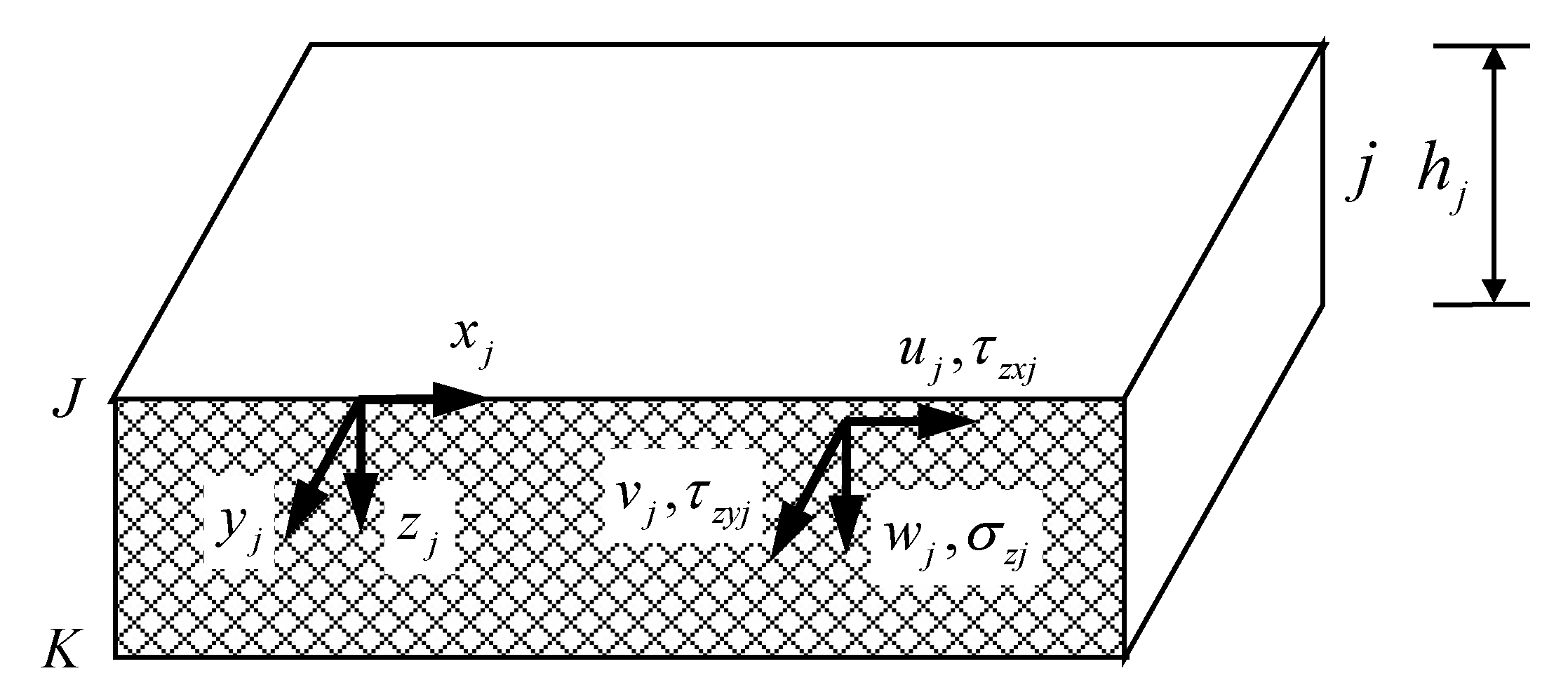

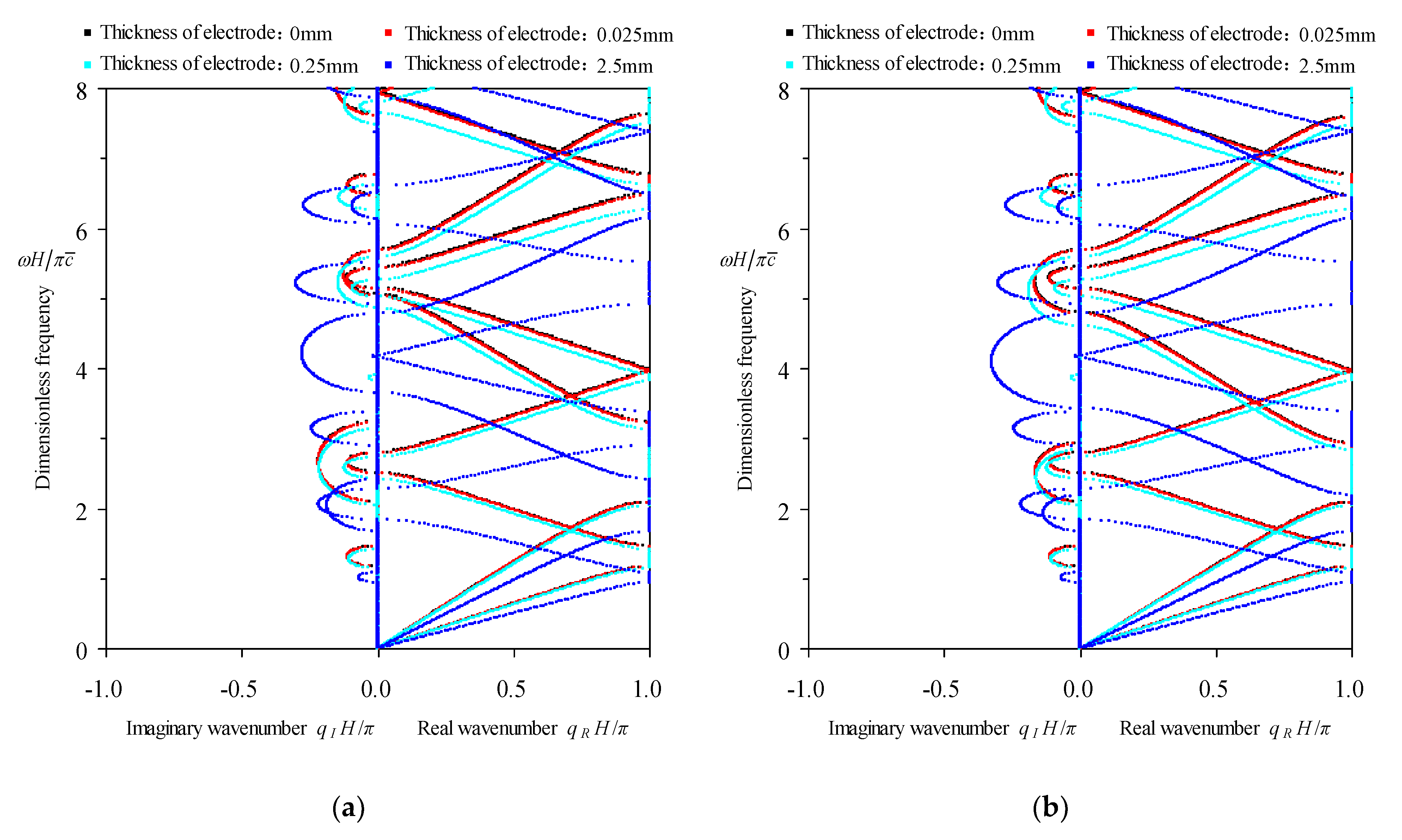

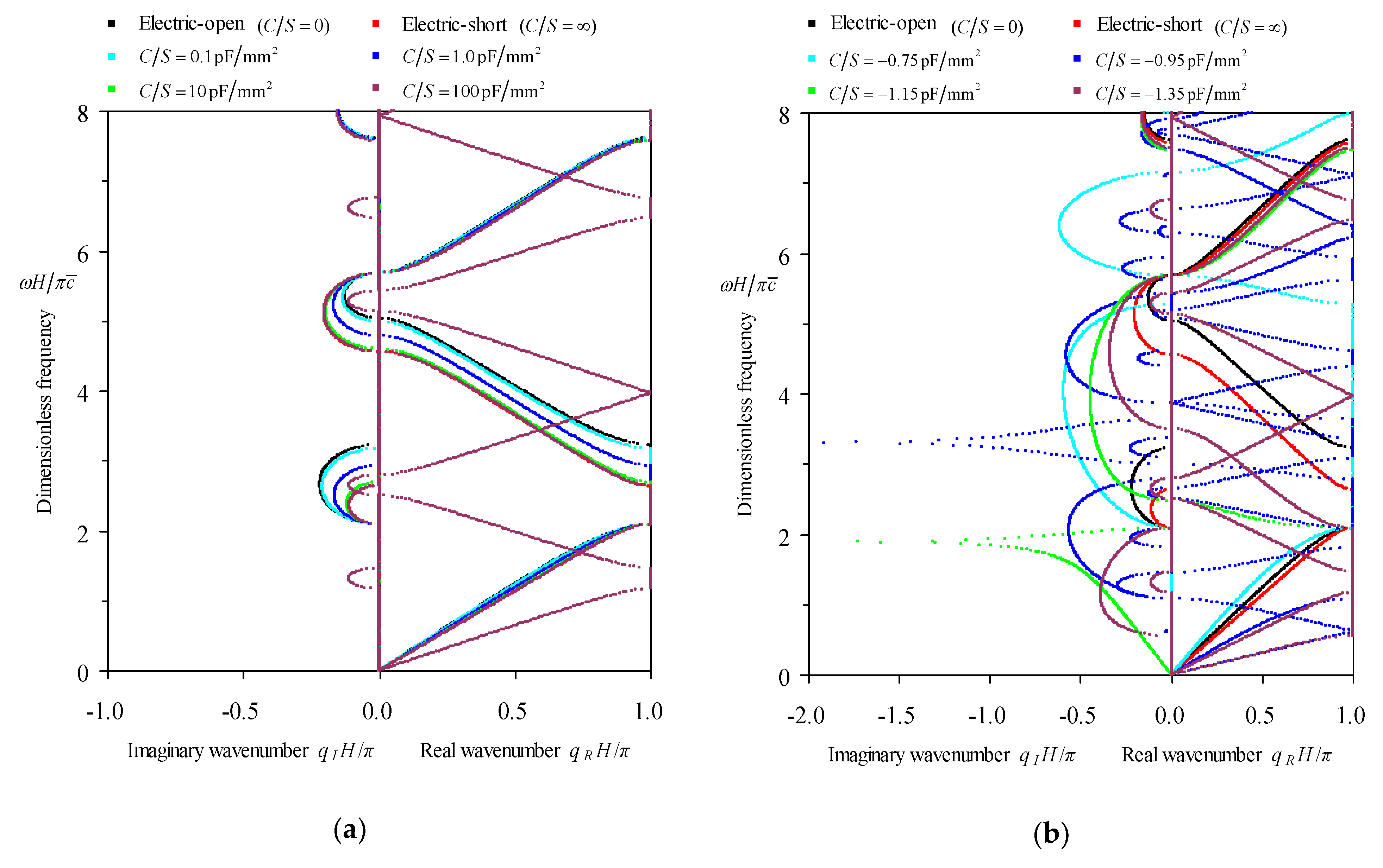
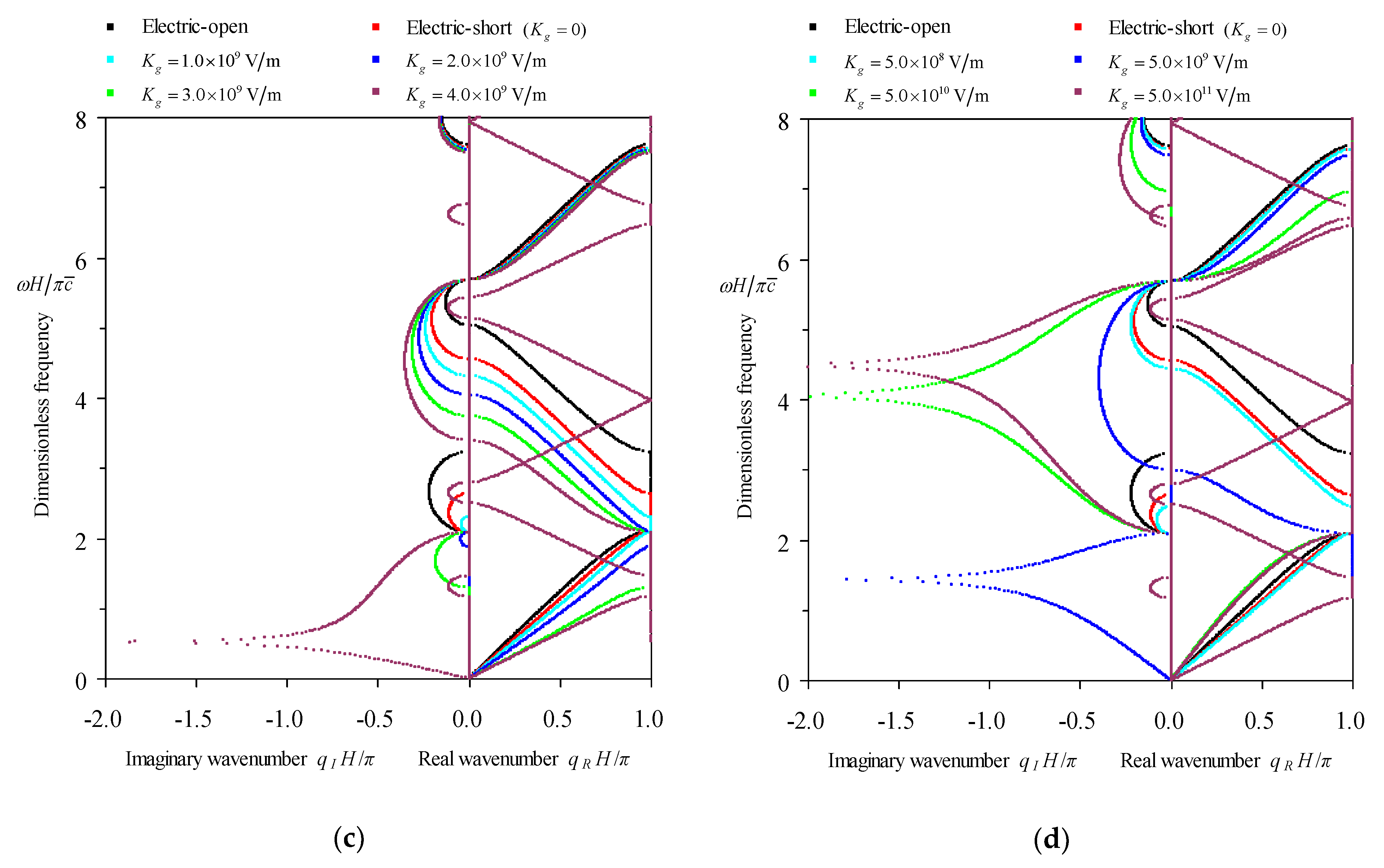


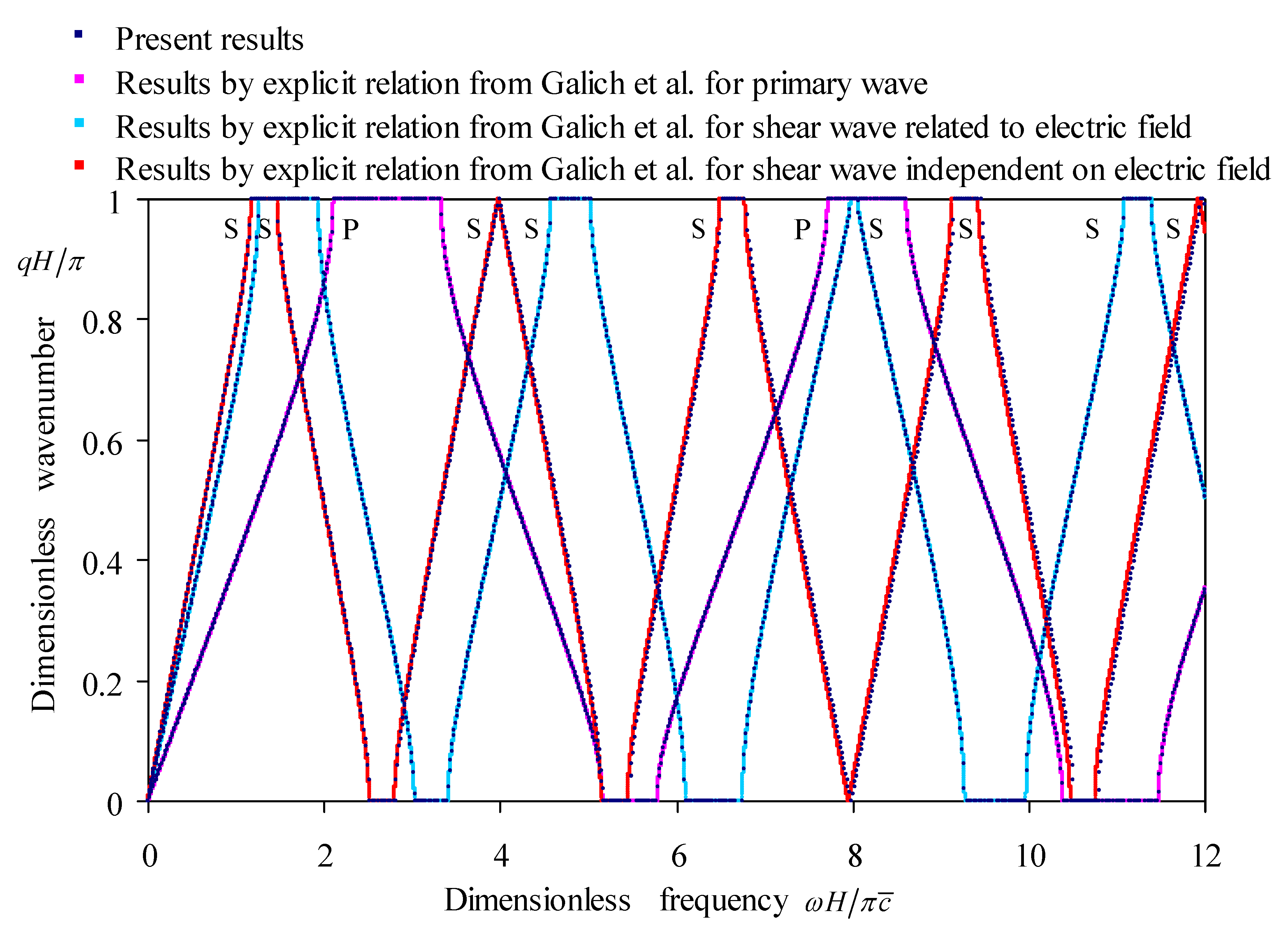

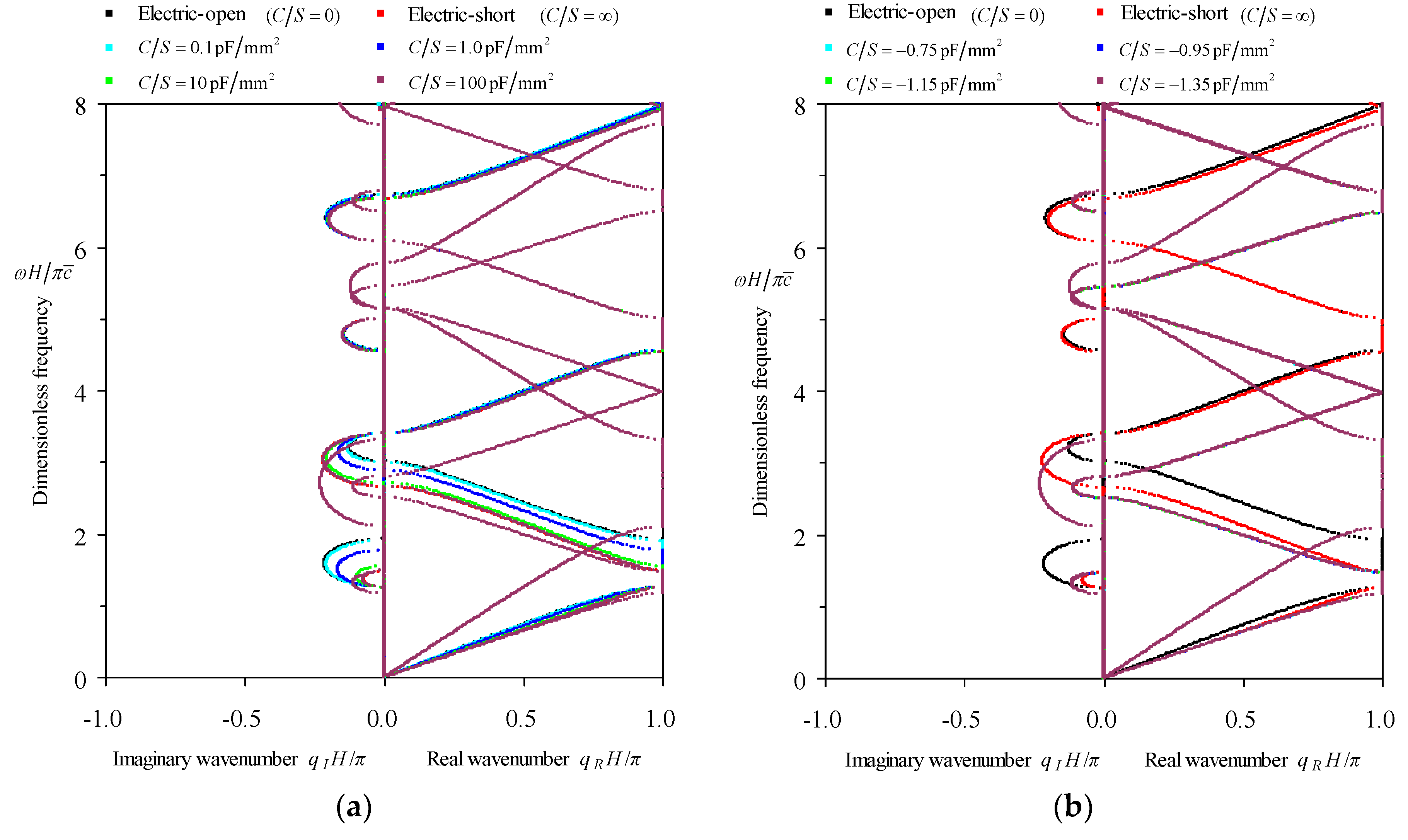
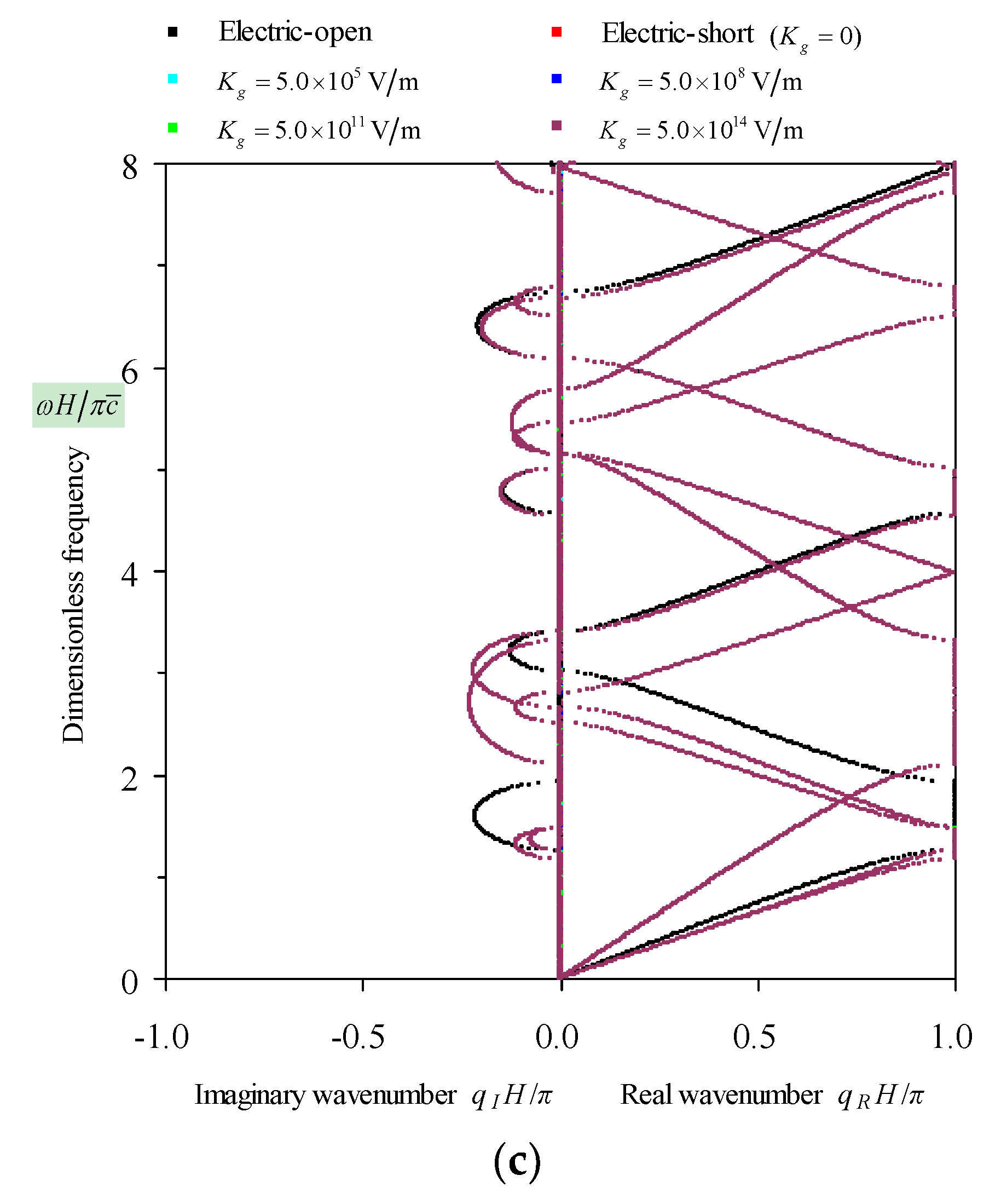
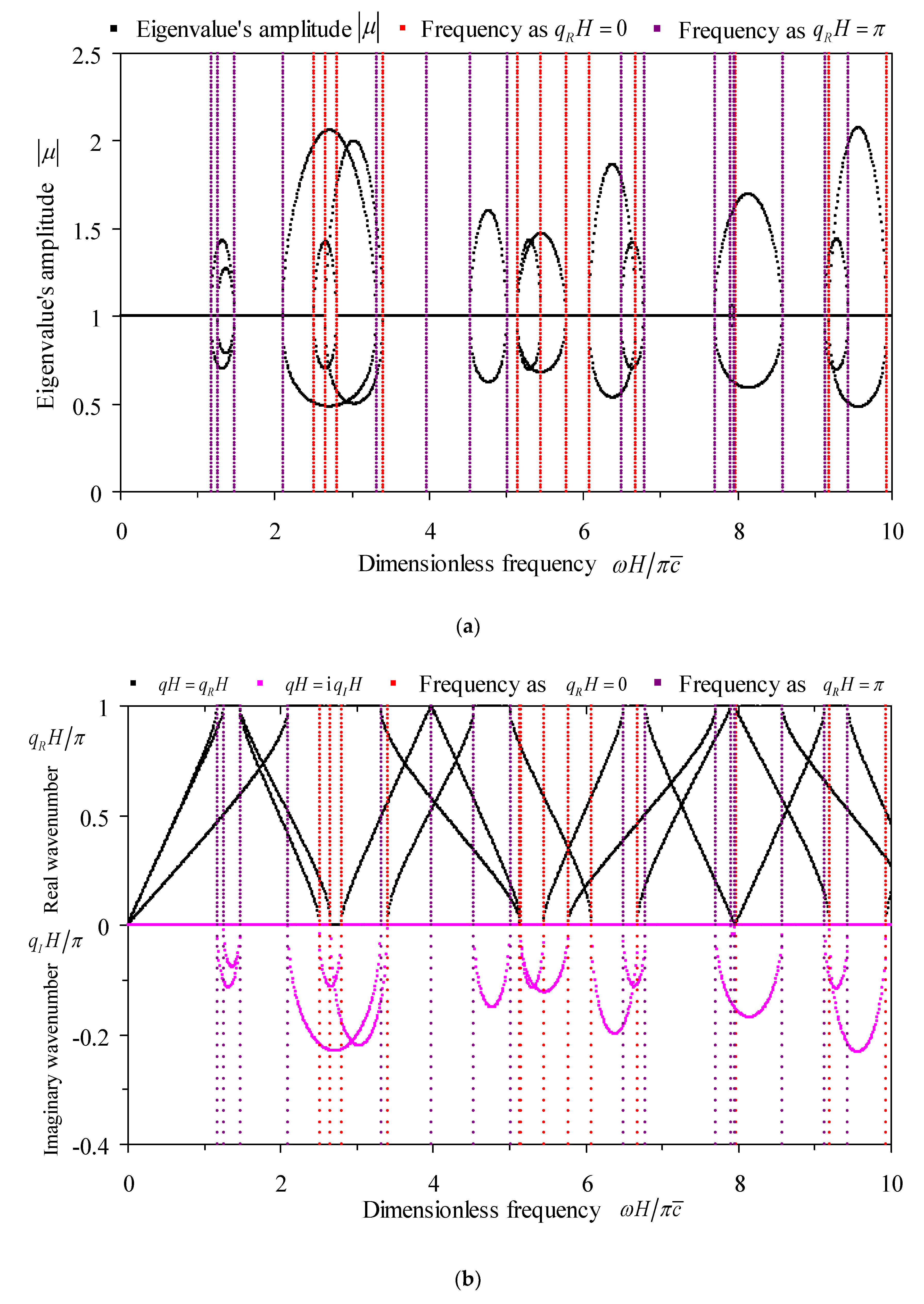
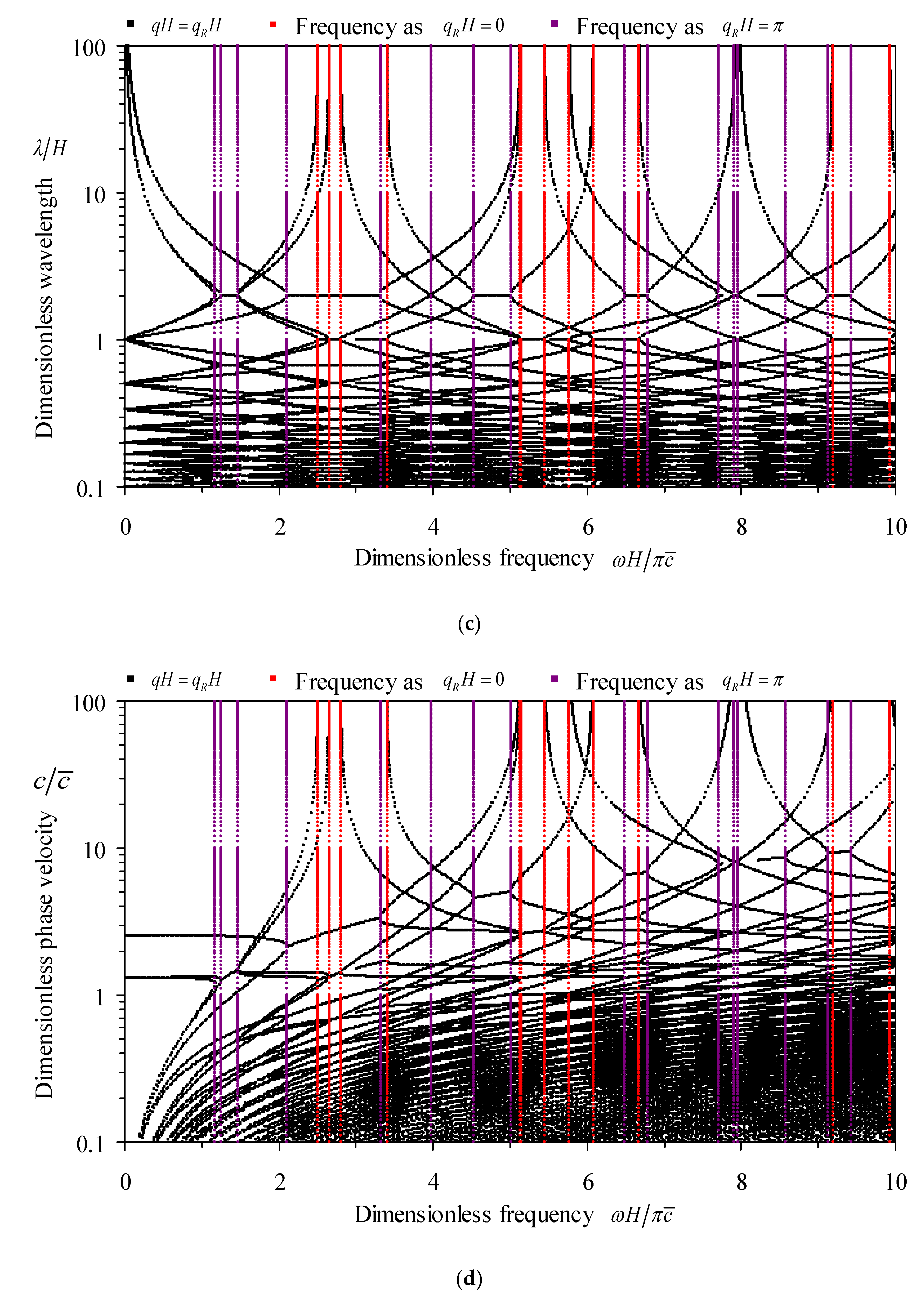
| Electrical Boundaries | Electric-open | Applied capacitance | Electric-short | Applied feedback control |
| Associated Mathematical Formulas |
| Electrical Boundaries | Expressions of Scalar | Expressions of Scalar | Expressions of Vector |
|---|---|---|---|
| Electric-open | |||
| Applied capacitance | |||
| Electric-short | |||
| Applied feedback control | 1 | 1 | 1 |
| Materials | PZT-5H1 | PZT-5H2 | Glass | Brass | |||
|---|---|---|---|---|---|---|---|
| Elastic constants | 12.600 | 7.421 | 8.334 | 16.246 | |||
| 12.600 | 12.600 | 8.334 | 16.246 | ||||
| 7.421 | 12.600 | 8.334 | 16.246 | ||||
| 7.950 | 8.410 | 2.300 | 8.258 | ||||
| 8.410 | 8.410 | 2.300 | 8.258 | ||||
| 8.410 | 7.950 | 2.300 | 8.258 | ||||
| 2.300 | 2.325 | 3.017 | 3.994 | ||||
| 2.300 | 2.300 | 3.017 | 3.994 | ||||
| 2.325 | 2.300 | 3.017 | 3.994 | ||||
| Piezoelectric constants | 17.000 | 17.000 | 0.000 (, ) | 0.000 (, ) | |||
| 17.000 | 17.000 | ||||||
| −6.500 | 19.200 | ||||||
| −6.500 | −6.500 | ||||||
| 19.200 | −6.500 | ||||||
| Dielectric constants | 150.518 | 83.300 | 0.354 | 0.000 | |||
| 150.518 | 150.518 | 0.354 | 0.000 | ||||
| 83.300 | 150.518 | 0.354 | 0.000 | ||||
| Material density | 7500 | 7500 | 2540 | 8320 | |||
© 2018 by the authors. Licensee MDPI, Basel, Switzerland. This article is an open access article distributed under the terms and conditions of the Creative Commons Attribution (CC BY) license (http://creativecommons.org/licenses/by/4.0/).
Share and Cite
Li, Q.; Guo, Y.; Wang, J.; Chen, W. Band Structures Analysis of Elastic Waves Propagating along Thickness Direction in Periodically Laminated Piezoelectric Composites. Crystals 2018, 8, 351. https://doi.org/10.3390/cryst8090351
Li Q, Guo Y, Wang J, Chen W. Band Structures Analysis of Elastic Waves Propagating along Thickness Direction in Periodically Laminated Piezoelectric Composites. Crystals. 2018; 8(9):351. https://doi.org/10.3390/cryst8090351
Chicago/Turabian StyleLi, Qiangqiang, Yongqiang Guo, Jingya Wang, and Wei Chen. 2018. "Band Structures Analysis of Elastic Waves Propagating along Thickness Direction in Periodically Laminated Piezoelectric Composites" Crystals 8, no. 9: 351. https://doi.org/10.3390/cryst8090351





